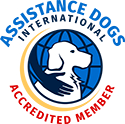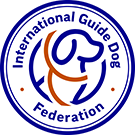Autism Service Dogs
Service dogs can address the following functional domains affected by autism:
SAFETY SKILLS ARE INCREASED BY:
-
Handle-led walking with a third party handler.
-
Autism service dogs wear a “squishy” handle attached to the service dog vest. The child with autism holds the handle while walking and the parent or caregiver holds the dog’s leash. The team is taught to only move forward when the handle is lifted and to stop moving when the handle is let go. This behavioral contingency is repeated over time and lends to the child’s ability to stay within a close proximity of the dog and third-party handler (parent or caregiver). Secondary leash walking, where the individual with autism holds an additional leash attached to the dog’s service dog vest is a variation of handle-led walking. This is considered for use on a case by case basis.
SOCIAL SKILLS ARE FACILITATED AND INCREASED BY:
-
Having the dog serve as a social catalyst to allow for opportunities to interact with peers. Giving permission when someone asks, “Can I pet your dog?”
COMMUNICATION SKILLS ARE INCREASED BY:
-
The dog serving as a motivator to evoke language. Giving the dog cues that empowers the individual when the dog actual obeys the cue!
ADAPTIVE SKILLS ARE DEVELOPED BY:
-
The child taking responsibility for caring for the dog; feeding, grooming, dressing with vest and leash.
-
Teaching the child to appropriately play and interact with the dog, increasing their leisure repertoire; games with balls, putting items away and laundry into basket.
SENSORY INTEGRATION PROCESSING DISORDER NEEDS ARE ADDRESSED BY:
-
Having the dog provide deep pressure (e.g., laying side by side or on top of the child) playing the game “squish” – to calm them down.
-
Utilizing the service dog for tactile input; grooming and petting.
THIRD-PARTY HANDLER
-
Although in typical service dog partnerships the individual with the disability handles the dog, a third party handler is usually necessary with autism service dogs. One or both parents must often receive extensive education in training and handling the dog to ensure the dog’s work skills are monitored and maintained.







